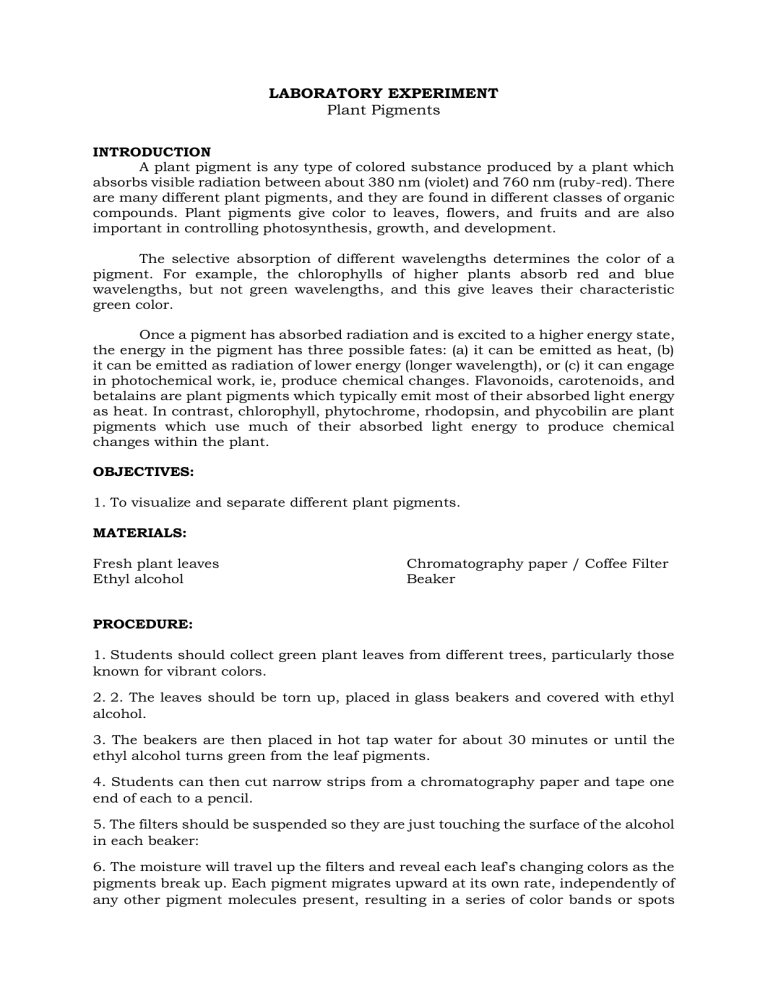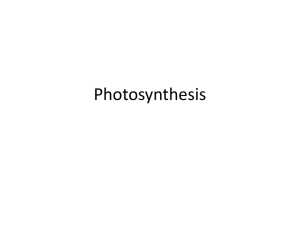Plant Pigment Lab Experiment: Chromatography Guide
advertisement

LABORATORY EXPERIMENT Plant Pigments INTRODUCTION A plant pigment is any type of colored substance produced by a plant which absorbs visible radiation between about 380 nm (violet) and 760 nm (ruby-red). There are many different plant pigments, and they are found in different classes of organic compounds. Plant pigments give color to leaves, flowers, and fruits and are also important in controlling photosynthesis, growth, and development. The selective absorption of different wavelengths determines the color of a pigment. For example, the chlorophylls of higher plants absorb red and blue wavelengths, but not green wavelengths, and this give leaves their characteristic green color. Once a pigment has absorbed radiation and is excited to a higher energy state, the energy in the pigment has three possible fates: (a) it can be emitted as heat, (b) it can be emitted as radiation of lower energy (longer wavelength), or (c) it can engage in photochemical work, ie, produce chemical changes. Flavonoids, carotenoids, and betalains are plant pigments which typically emit most of their absorbed light energy as heat. In contrast, chlorophyll, phytochrome, rhodopsin, and phycobilin are plant pigments which use much of their absorbed light energy to produce chemical changes within the plant. OBJECTIVES: 1. To visualize and separate different plant pigments. MATERIALS: Fresh plant leaves Ethyl alcohol Chromatography paper / Coffee Filter Beaker PROCEDURE: 1. Students should collect green plant leaves from different trees, particularly those known for vibrant colors. 2. 2. The leaves should be torn up, placed in glass beakers and covered with ethyl alcohol. 3. The beakers are then placed in hot tap water for about 30 minutes or until the ethyl alcohol turns green from the leaf pigments. 4. Students can then cut narrow strips from a chromatography paper and tape one end of each to a pencil. 5. The filters should be suspended so they are just touching the surface of the alcohol in each beaker: 6. The moisture will travel up the filters and reveal each leaf's changing colors as the pigments break up. Each pigment migrates upward at its own rate, independently of any other pigment molecules present, resulting in a series of color bands or spots vertically spaced at different levels on the paper strip. The distance any pigment moves upward is specific for that pigment under a given set of conditions. Yellow-orange - carotenes 2 yellow bands - xanthophylls Blue-green - chlorophyll a Yellow-green - chlorophyll b Name: Group No: Section: Date Performed: Date Submitted: Rating: DOCUMENTATIONS: LABORATORY ACTIVITY PLANT PIGMENTS PLANT LEAVES #1 PLANT LEAVES #2 OBSERVATIONS: POST-LABORATORY QUESTIONS: 1. How many pigments are there in a plant that you use? 2. What type of plant pigments did you see in the filter paper? 3. Where are the photosynthetic pigments located in a plant cell? 4. Why leaves in general appear green although they possess yellow and orange pigments?




